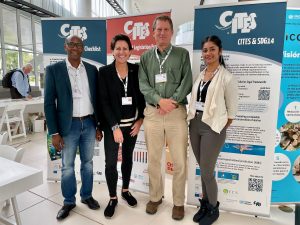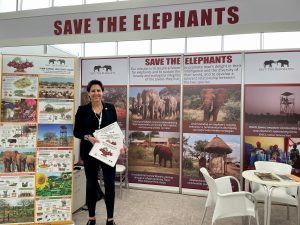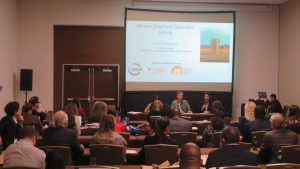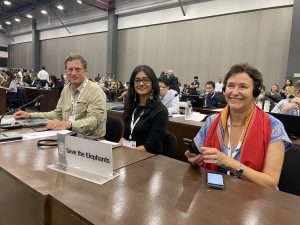I was fortunate to be part of the Save the Elephants team that attended CITES (the Convention on International Trade of Endangered Species of Fauna and Flora) in Panama City in November 2022. It was incredible to see all the different representatives from around the globe gathered in one place to discuss important wildlife matters. Our team comprised Dr. Lucy King (Head of Human-Elephant Coexistence Program), Dr. Chris Thouless (Director of Research & Elephant Crisis Fund), Dr. Festus Ihwagi (Research Scientist in Spatial Ecology) and myself.

Left to right: Festus, Lucy, Chris and myself at the CITES booth
One of the main focuses of our trip was to present our new Human-Elephant Coexistence Toolbox manual at the event. The Toolbox is a beautifully illustrated manual of tried and tested 80+ elephant deterrent methods aimed to empower rural African communities and reduce human-elephant conflict. We arrived in Panama City laden with suitcases full of copies of the manual, in English, French and Swahili, ready to hand them out to anyone who might be interested. We didn’t realize just how popular they would be! We managed to distribute a total of 100 copies of the toolbox to 28 countries. We also held a special side event, presented by Drs King and Thouless, to introduce the Toolbox to the CITES delegation.
We had many visitors to our booth showing interest in the Toolbox, including NGOs and government officials who shared their stories of human-elephant conflict (HEC). Representatives from the Southern African, in particular, told us how critical the situation was in their countries and expressed their concerns at how quickly HEC was escalating. There were also lots of questions about the effectiveness of the Toolbox which our team was able to address by showing examples of just how successful many of the tried and tested methods were across Africa. The level of interest in the Toolbox at CITES was a positive indication that we are on the right track and that it has the potential to make a positive impact to communities that urgently need solutions.

Dr. Lucy King with the HEC Toolbox manual at CITES © Meha Kumar
But it wasn’t all about the Toolbox. Our team also took part in some very important discussions around wild elephant welfare including a very heated debate over a proposal by several African countries to export live elephants from the wild outside the continent. To our relief, the proposal was rejected with CITES agreeing that the trade in live African elephants should be limited to ‘in situ conservation programmes or secure areas in the wild within the species’ natural and historical range in Africa.’ It was a relief to hear delegates recognising elephants as ‘highly social animals’ and that removal from their social groups would disrupt the wild populations and have ‘detrimental effects on the physical, behavioural and social well-being of elephants removed from these groups.”
There was also tension around a proposal from Burkina Faso, Equatorial Guinea, Senegal and Mali to uplist the status of all wild African elephants from Appendix II to Appendix I. This proposal, which was rejected, would have meant that all species of African Elephants would have received maximum protection across the continent, reducing the pressure from ivory poachers, if it had been successful. A second proposal amendment from Botswana, Zimbabwe, South Africa and Namibia to request to sell elephant ivory and hides was likewise rejected by a wide majority of the parties.
STE’s Dr Thouless was part of a panel that presented the new IUCN African Elephant Specialist Group report on forest elephants at CITES. Preliminary results from the latest status report indicate that the catastrophic decline in forest elephant numbers has stopped. The bad news, however, is that the vast majority of those critically endangered elephants are now found in only two countries – Gabon and Congo. In presenting the report, the panel warned that while Gabon and Congo were bright spots for forest elephants, critical action was still needed in the far reaches of the species’ range.

Dr. Thouless (second from right) with the IUCN African Elephant Specialist Group team presenting the African Forest Elephants report at CITES © Festus Ihwagi
A Kenyan proposal to establish a fund accessible to range states upon non-commercial disposal of ivory stockpiles was rejected. This fund, if it had been accepted, would have prevented the resumption of commercial ivory sales or buyouts, further providing support for elephant conservation and promotion of human-elephant coexistence. However, Dr Ihwagi later told me that the ‘the CITES event on elephant proposals was a substantial success despite losing on the Kenyan proposal.”
After 11 days in Panama, our weary team returned to Kenya with a renewed sense of hope for the future of elephants, lots of important new contacts and allies from the elephant conservation world, and excitement around the incredible response we received to our new Human-Elephant Coexistence Toolbox book.

STE team all smiles at CITES © Lucy King

